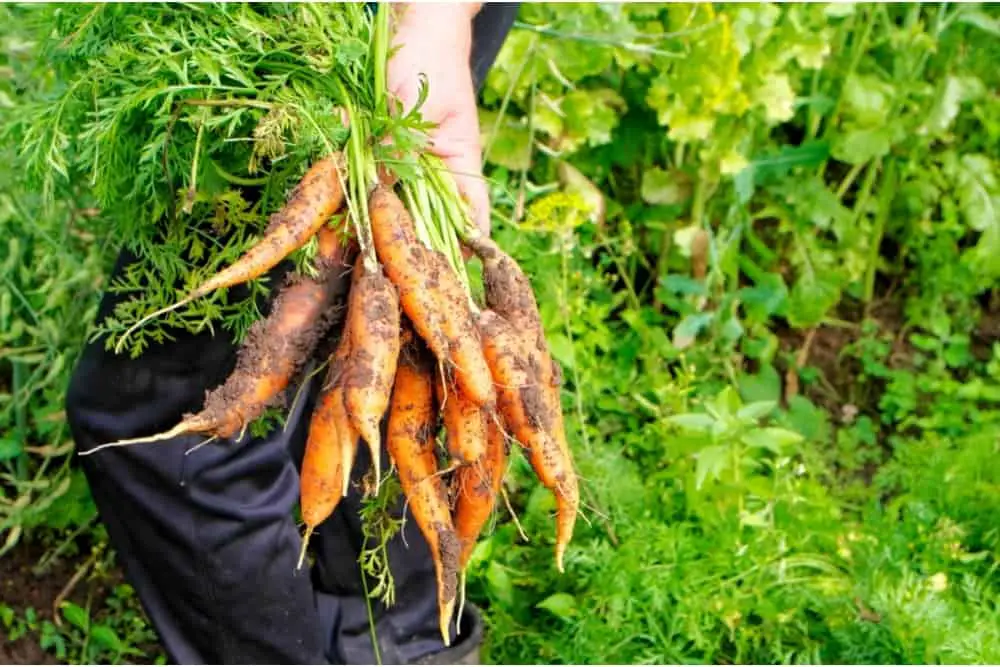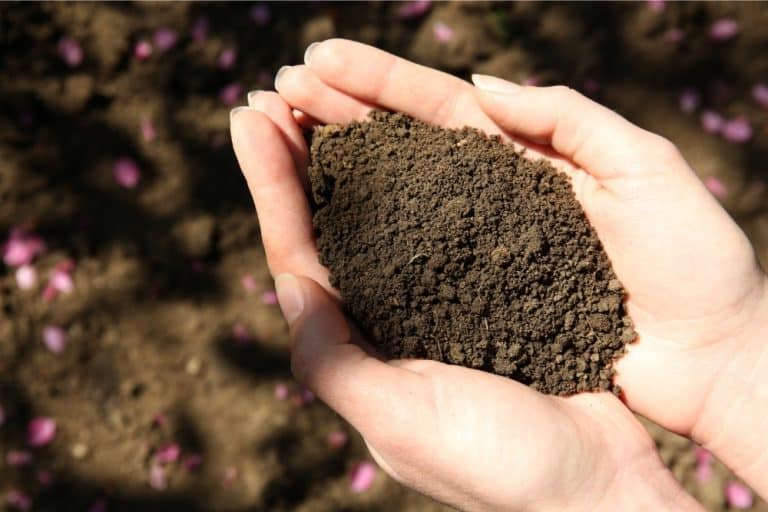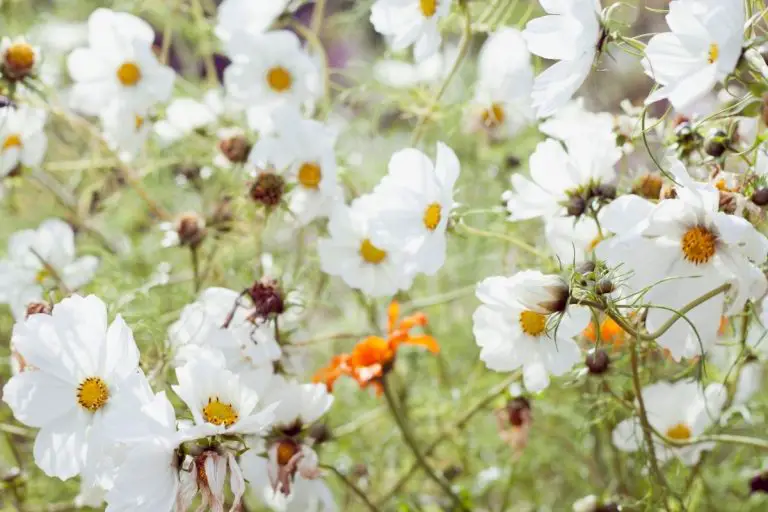When To Pick Carrots [+ Harvesting Tips!]
Want to know When To Pick Carrots? Here is a quick and easy guide, so you can have delicious crunchy carrots in no time!
It’s officially fall! That means it’s the peak season for harvesting carrots. While some carrots can technically be grown year-round, it’s during spring and fall that these tasty and nutritious vegetables are at their best.
Perfect raw for a healthy snack, cooked into a delicious pie or casserole, or simply roasted with a honey glaze, carrots are a versatile and long-lasting root vegetable that will serve you well in recipes for weeks to come.
But when’s the best time to pick your carrots? Luckily for you, we’ve got you covered with some simple and easy tips for carrot harvesting.
Seed your carrots quickly and efficiently using a row seeder with ideal seed spacings. This will save you the time for thinning your carrots and avoid them intergrowing in a bunch!

DISCLOSURE
Some of the links on here are affiliate links and I may earn if you click on them, AT NO EXTRA cost to you. Hope you find the information here useful! Thanks.
Related Articles:
- Best Seed Starting Kit Of 2022
- Best Vegetables To Grow In Raised Beds: 11 Delicious Crops!
- How to Start Your Own Permaculture Vegetable Garden
- How To Harvest Broccoli The RIGHT Way!
What Carrots Do I Have?
Grow times can differ between varieties of carrots. The quickest and easiest way to check what carrots you have is to check the seed packet.
We recommend keeping a hold of the seed packets when growing any veg, because there’s always some handy information about growing times, the variety, and the best times to plant them.
The variety can make a big difference to when you pick your carrots; baby carrots take less time to grow than mature carrots, so if you have a mix then you should be mindful of which varieties are growing in which plots.
Note– If you want to make your green fingers happier and your life easier, you can use this affordable 83 pieces ultimate gardening set to help you garden like a pro!
When’s the Best Time To Pick My Carrots?
This depends on the type of carrot you have. Baby carrots tend to be ready between 50-60 days after you first plant them. Mature carrots, on the other hand, take a bit longer.
These are ready for picking at around the 75-day mark. Some carrots may take more or less time than this, so don’t be afraid to look at your seed packet to see the recommended growing times for your variety!
Half-long varieties like Little Finger and Thumbelina will reach maturity faster than long root carrots, and you can harvest these anywhere from 55-70 days after planting.
Long root varieties such as Tendersweet and Gold Pak will benefit from a little bit longer in the ground. Harvest these between days 70-80.
It’s important to bear in mind that these times are averages. To make sure you’re getting the best harvest possible, you’ll have to use a bit of observation to tell when your carrots are ready. If you pick a carrot and it’s clearly not ready, just leave them to grow a bit more.
When your carrots reach the stage where you can pick them, you should be able to see the tops just poking out of the top of the soil. The perfect carrots will be around ½ to ¾ inches in diameter.
The leaves on top will be a bright, healthy green, and the carrots themselves should be a vibrant orange (as long as you aren’t growing purple or white carrots, of course).
When harvesting your carrots, there are a few things you should look out for. First of all, it’s unlikely for your carrots to come out looking like the ones you’ll find at the grocery store. So don’t worry if they’re crooked or knobbly, they’ll still taste delicious!
Consider purchasing organic, Non-GMO, Open-pollinated vegetable seeds for healthy vegetables from seed to harvest!

Depending on your crop size, you should consider how many carrots you’ll be using within a 2-4 week period. If you won’t be able to use them all, you can leave them in the ground for a little longer to keep them from rotting in your fridge.
This works especially well now that we’re heading into colder months. The cold soil will act as a natural refrigerator, and if your area is prone to cold snaps and frosts, all the better – carrots actually get sweeter after surface frosts!
If you have too many carrots and are expecting to get a few days of frost, prepare for the best carrot cake you’ll ever make. Just be sure to pick the leftover carrots before the weather starts warming up for spring.

Why You Should Make Sure To Harvest Your Carrots on Time
While you’ll want to leave mature and long-rooted carrots to grow for longer than half-long and baby carrot varieties, it’s important not to leave them in the ground for too long.
Carrots that continue to grow past their prime will start to turn bitter. The tops may also die, especially during winter. This will make it harder to find your carrots, and the carrot itself may also begin to rot.
Keeping your carrots in the ground has its benefits, but don’t forget that there’s a deadline for a reason!
How To Pick and Store Your Harvested Carrots
Now that you know when to pick your carrots, here are a few tips on actually harvesting and storing them.
You don’t want to just grab the leaves and pull – that’s a great way to get a handful of leaves with no carrot on the end. Instead, loosen up the soil around the carrot with a fork or trowel to free up the carrot. Now you can pull them out.
Get your lightweight fibreglass garden fork to ease your carrot harvesting!

As we mentioned before, plan for how many carrots you’re going to be using. If you have too many to eat before they’ll go off, leave a few in the ground.
Carrots lose moisture through their tops, so make sure to chop all but ½ inch of these off after harvesting. Wash the carrots you’ll be using first, but leave the dirt on ones you’ll be using later to help them last longer.
To store your carrots, you can wrap them in a paper towel, put them in a ziplock bag and store them in the refrigerator to keep for several weeks. Alternatively, keep them in a cool dry place and they’ll last several months.

Left It Too Late?
Don’t fret! A great thing about carrots is that they’re biennial plants – essentially, this means that any carrots leftover during winter will begin to grow again in the spring.
The nutrients in the carrot and its roots are great for the soil too. If you forget to pick your carrots or miss a few, they’ll enrich your soil as well as sowing new seeds themselves that will grow into carrots next season.
Final Thoughts
Now that you know when to pick your carrots, the only thing left is to do it! Just follow these tips and you’ll get a great harvest of carrots ready to be made into some delicious fall recipes.
Good luck, and enjoy!
Related Articles


![Why Is My Plant Drooping?[And How To Fix It!]](https://aboveandbeyondgardening.com/wp-content/uploads/2021/10/Why-Is-My-Plant-Drooping-768x735.jpg)


![15 Companion Plants For Asparagus To Help It THRIVE! [2023]](https://aboveandbeyondgardening.com/wp-content/uploads/2022/11/companion-plants-for-asparagus-768x510.jpg)

![Growing Kale Indoors Hydroponically: A Step By Step Guide [2023]](https://aboveandbeyondgardening.com/wp-content/uploads/2022/10/Growing-Kale-Indoors-Hydroponically-1-768x512.jpg)
